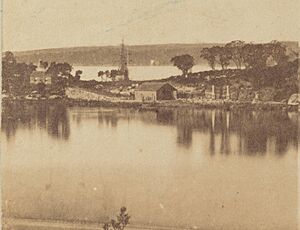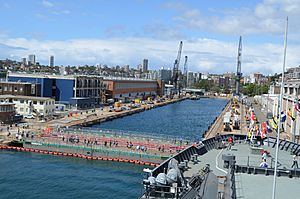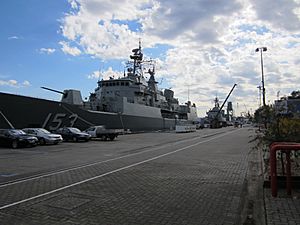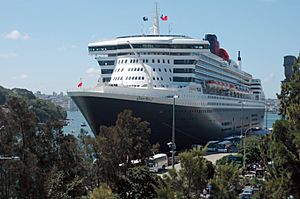Garden Island (New South Wales) facts for kids
Quick facts for kids Garden IslandSydney, New South Wales |
|||||||||||||||
|---|---|---|---|---|---|---|---|---|---|---|---|---|---|---|---|

Garden Island from Sydney Tower, in 2007
|
|||||||||||||||
| Postcode(s) | 2000 | ||||||||||||||
| Location | 2 km (1 mi) north-east of Sydney CBD | ||||||||||||||
| LGA(s) | City of Sydney | ||||||||||||||
|
|||||||||||||||
Garden Island is a special area in Sydney, Australia. It is home to a big base for the Royal Australian Navy (RAN), which is Australia's navy. This important place is located north-east of the main city area of Sydney and sticks out into Port Jackson, which is Sydney Harbour.
For a long time, since the first Europeans arrived in Australia, Garden Island has been used by the government and navy. It used to be a separate island. But during World War II, a lot of land was added to connect it to the nearby area called Potts Point.
Today, Garden Island is a key part of the Navy's Fleet Base East. It has busy shipyards, including a huge dry dock called the Captain Cook Graving Dock. There are also naval wharves where ships can dock. About half of the Navy's main ships use these wharves as their home.
The very top part of Garden Island is open to the public. Here you can find the Royal Australian Navy Heritage Centre museum. This area also has old naval items and monuments outside. Right next to Garden Island, on the land, is HMAS Kuttabul. This is the Navy's main office, training, and support base for Sydney. Even though they are separate, people often use the names Garden Island and HMAS Kuttabul to mean the same place.
Contents
Geography of Garden Island
Garden Island was once a true island in Sydney Harbour. However, the naval base grew bigger. A large dry dock was built in the water between the island and the mainland. This work connected Garden Island to the shore at Potts Point in the 1940s. Now, the naval base's wharves stretch along the eastern side of Woolloomooloo Bay. They go from the suburb of Woolloomooloo all the way to where the original island ended.
History of Garden Island
The First Nations people called this small island 'Bayinguwa'. It was renamed Garden Island in 1788. This happened after officers and crew from the First Fleet ship HMS Sirius planted a kitchen garden there. They wanted to grow food for themselves.
You can still see initials carved into a sandstone rock on the island. These are believed to be the oldest colonial graffiti in Australia. They say "FM 1788," which stands for Frederick Meredith. He was a steward on the Sirius.
In 1811, Garden Island was meant to become part of the Governor's land. The food grown there was only for Government House. But because of a mistake, the Navy kept legal ownership. They got the land back in 1866.
Strong stone forts were built on the island in the 1820s. These were to protect Sydney from a possible attack. These old forts are still there today. Garden Island also has what is said to be Australia's first lawn tennis court. It was built in 1880 and is still used, though the grass was changed in 1960.
Captain Cook Graving Dock
Before World War II, the closest large naval dry dock was very far away in Singapore. It was an 8,000-mile trip for a damaged warship. So, in 1938, Australia decided to build a big naval dry dock. A dry dock is like a giant bathtub for ships. Water is pumped out so workers can fix the ship's bottom.
Building this dock was going to be expensive. Three possible places were looked at in Sydney Harbour. Potts Point was chosen as the best spot. The dock was built by adding about 30 acres of new land. This new land connected Garden Island to the mainland.
By September 1944, the dock was almost ready. On March 2, 1945, a British aircraft carrier, HMS Illustrious, used the dock in an emergency. The Captain Cook Graving Dock officially opened on March 24, 1945. The British battleship HMS Anson was the largest ship to use the dock. It weighed 45,360 tons!
The dock is about 1,139 feet long and 147 feet wide. It is 45 feet deep during high tide. When full, it holds 50 million gallons of water. The dock can be emptied in just four hours. This is done using three huge pumps that can move 70,500 gallons of water per minute.
Hammerhead Crane
The hammerhead crane was built between 1944 and 1951 at Garden Island. This giant electric crane was 203 feet tall. It could reach out 131 feet. Its main job was to lift and install heavy parts like gun turrets on warships. It could lift up to 250 tonnes! The crane was last used in 1996.
In 2013, the government decided to remove the hammerhead crane. It cost about $10.3 million to take it down. Other ideas, like keeping it as a tourist spot, were too expensive. Also, removing it made more space for new, large Navy ships. When it was finished, the Hammerhead Crane was the biggest crane in the Southern Hemisphere. In 2005, it was still the largest in Australia. By 2014, it was fully removed, but some parts were saved for history.
Tunnel System
There is a system of tunnels under Garden Island. The Royal Australian Navy used these tunnels in the past. Inside these tunnels, there was a power station, offices, and places for people to hide during air raids. There was also a command center in the tunnels. Other tunnels went further towards Kings Cross. The island also has an old pit from the 1800s. This pit was used to store things if the island was attacked. The entrance to this pit is now sealed.
Current Usage
Dockyard Facilities
Today, the dockyard facilities at Garden Island are run by a company called Thales Australia. They are a defense contractor. They use the dockyard to fix and maintain both naval ships and civilian boats.
The many wharves along Garden Island are still controlled by the Navy. They are the home port for about half of the Royal Australian Navy's main ships. The wharves on the western side of the island are deep enough for even the largest United States Navy aircraft carriers to dock there.
The Royal Australian Navy Heritage Centre opened in 2005. It is the official museum of the Royal Australian Navy. You can find it in the public area at the northern end of Garden Island. This area was opened to the public in 2002. It has several old buildings, historical items, and naval monuments. One special exhibit at the museum is the top part of a Japanese midget submarine. This submarine attacked Sydney Harbour in 1942.
Getting to this heritage area is a bit tricky because it's surrounded by the naval base. You can usually get there by taking a Sydney Ferry from Circular Quay to Double Bay. The Garden Island ferry wharf is at the north end of the island. Sometimes, pre-booked bus groups can drive through the naval base to get to the museum, but under strict rules.
Other Facilities
Many workshops and other buildings on Garden Island are managed by the nearby HMAS Kuttabul naval base. These buildings are used for training and other support activities for the Navy.
Proposed Future Usage
Since the year 2000, many very large cruise ships have been built. Some of these ships are too big to dock at the main cruise ship terminal in Circular Quay. Because of this, some large cruise ships have been allowed to dock at Garden Island's naval wharves. At first, this happened only sometimes. Then, in 2012, an agreement allowed three cruise ships to dock there each year.
Some people want more cruise ships to use the naval wharves. They even suggest that the Navy should move its base entirely. If the naval base moved, Garden Island could be used for a cruise ship terminal or even new homes along the harbor.
However, the Navy and the Department of Defence do not agree with these ideas. They say that having more civilians on the base would create security risks. It would also mean the Navy would lose important abilities. Moving the base to a new place would be extremely expensive. A report in 2013 estimated it would cost over $6 billion. Most other possible locations for a new base would need constant dredging to allow large naval ships to enter. Their access channels are also narrow, which could be easily blocked during a war.
Historic Buildings and Structures
The first naval buildings on Garden Island were small. But in the 1880s, the Admiralty (the British Navy's headquarters) started to invest more money. They wanted to make Garden Island a major base for the Royal Navy in the southern part of the world. Many large buildings were constructed. Several of these were designed by a famous architect named James Barnet. These buildings provided places for people to live, offices, storage areas, and a big factory for steam engines. Later, the Royal Australian Navy took over these buildings. Most of them are still used today.
Heritage listings
Garden Island has several sites that are listed as heritage places, including:
- Cowper Wharf Roadway: Sydney Harbour Naval Precinct
Images for kids













